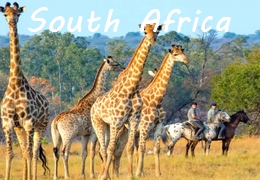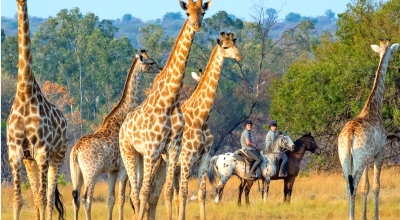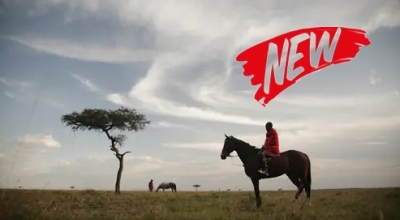Live your dream: Go on a horseback safari to discover African wildlife and exceptionally wild landscapes: the dream of many riders ! We offer horseback safaris: in Botswana, in South Africa, in Kenya, and Namibia. Progressive horseback safaris with accommodation in comfortable camps like in the film "Out of Africa", or a stationary horseback riding safari around a comfortable lodge !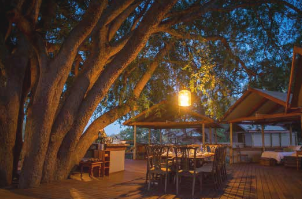 Encounter African wildlife on a horseback safari in South Africa , in Botswana, in Namibia, in Kenya. An equestrian progressive safari in open spaces, meeting lions and elephants, is limited to experienced riders, while a stationary horseback safari in areas without dangerous game, are open to all abilities and families: non-equestrian activities are usually offered and non-riders can join a stationary safari.
Encounter African wildlife on a horseback safari in South Africa , in Botswana, in Namibia, in Kenya. An equestrian progressive safari in open spaces, meeting lions and elephants, is limited to experienced riders, while a stationary horseback safari in areas without dangerous game, are open to all abilities and families: non-equestrian activities are usually offered and non-riders can join a stationary safari.
We offer equestrian safaris: in Botswana, South Africa, Kenya, and Namibia:
OUR MOST POPULAR SAFARI : SOUTH AFRICA & BOTSWANA EXPLORER SAFARI :

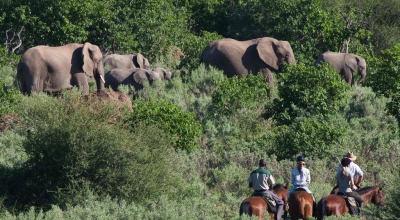
Safari
The most popular horseback safari in South Africa and Botswana
100 € discount for registrations received before 15/12 !
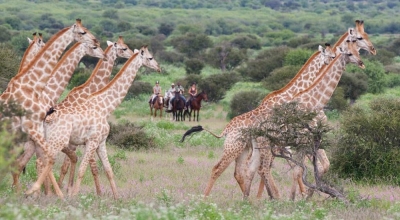
Safari
Live your dream: go on a horseback safari in Botswana
100 € discount for registrations received before 15/12 !
CLIMATE:
Month | Jan | Feb | Mar | Apr | May | Jun | Jul | Aug | Sep | Oct | Nov | Dec |
Average High Temperature (°F) | 84 | 84 | 82 | 79 | 75 | 70 | 70 | 75 | 80 | 82 | 83 | 84 |
Average Low Temperature (°F) | 63 | 62 | 60 | 54 | 47 | 41 | 41 | 45 | 51 | 56 | 59 | 62 |
Average High Temperature (°C) | 29 | 29 | 28 | 26 | 24 | 21 | 21 | 24 | 27 | 28 | 28 | 29 |
Average Low Temperature (°C) | 17 | 17 | 16 | 12 | 8 | 5 | 5 | 7 | 11 | 13 | 15 | 17 |
Average Precipitation (days of rain) | 10 | 8 | 8 | 6 | 1 | 0 | 0 | 0 | 1 | 6 | 10 | 11 |
SEASONS:
The climate over most of Southern Africa is temperate. Hot, dry conditions are usually encountered in the Tuli region. Heavy summer thunderstorms of short duration in the late afternoon and evening may be experienced. Rainfall occurs mostly during the summer months (October - March).
Summer (December to February):
The temperatures are high and there is a lot of humidity in the air. The chances of convectional thunderstorms are great. Some of the summer migrant birds begin to arrive. The characteristic call of the Red-chested Cuckoo rings out clearly, heralding the approach of better times for all. Once good rains have fallen, the small, drab, but extremely vocal Monotonous Lark keeps the bush awake day and night with its irritating call, as they perch on every treetop.
Kudus calve and there is a good chance of seeing late Impala lambs, tottering along on spindly, wobbling legs behind their mothers. Due to the heat, the animals wisely begin to seek shade before 8 o’clock in the morning, only becoming active again in the late afternoon, just prior to sunset. Tropical thunderstorms are a regular afternoon feature and there is a high probability of flooded rivers to add some excitement to game drives.
Autumn (March to May):
The transition from summer to winter occurs rapidly in the Limpopo Valley. Finally the searing heat of summer begins to abate and there is less likelihood of rain. This is a truly splendid time of the year. It is now Autumn and the daily temperatures are most pleasant with balmy days and nights. Temperatures begin to drop rapidly after sunset and both evening and morning game drives require warmer clothing. Although chilly in the morning, the days are clear and pleasant with crisp blue skies. Now that the rains are over, the veldt begins to dry out and game begins to congregate around the major watercourses, such as the Limpopo and associated wetlands, as well as the artificial waterholes scattered throughout the reserve.
A few late Kudu calves may make a bemused appearance in the beginning of March. Large nursery herds of gawky Impala young are found, kept under some control by the watchful eyes of their mothers.
The bush is still dense, but the bright shades of green are starting to become duller as the year progresses. As the vegetation begins to thin, the elusive leopard is more frequently seen. Lions, which dispersed with the game during the wet season, now begin to concentrate their activities in the central area of Mashatu.
Winter (June to August):
Winter is now upon us and has spread its chilly grip on Mashatu. The days are still good, with crisp mornings. The nights can be very cold.
Most of the natural pans and pools have now completely dried up. Elephant and a host of other species begin to frequent the artificial waterholes at both Main and Tent Camps, which makes for exciting mealtime viewing. Predator sightings are good at this time of the year, due to the thinned out vegetation and concentrations of game, cheetah however are scarce. In general the game is more active later into the day.
This is also a favorable time to visit the archaeological site at the Motloutse River. The summer vegetation has disappeared and a host of interesting features are now visible.
Towards the end of winter, the floodplains and grasslands adjacent to the Limpopo are very dry and barren. The bush has become harsh and almost inhospitable, with absolutely no groundcover, only dust and rocks visible for kilometers. The veldt has all the typical winter hues of brown and red, as the Mopane leaves start turning. The weather is fine with temperatures increasing slightly. The early mornings and evenings being not as cold as in June or July. August is a showy month, with respect to sunsets. Due to the very dry conditions, large quantities of dust is taken up into the air, giving rise to spectacular pyrotechnic displays as the sun sinks below the horizon.
Spring (September to November):
The bush is still very dry, a condition exacerbated by winds, which blow from August through to October. Temperatures begin to steadily increase and conditions are becoming desperate for many of the herbivores. This is due to sub region frontal systems touching on the Limpopo Valley, bringing superheated air into the region. There may be an occasional tropical thunderstorm, but this early rain is sucked up like a sponge by the barren earth. This welcome water is however not enough, and seldom results in a notable floral display. Many trees begin to blossom, in anticipation of the rapidly approaching summer. The vibrant hues of the blossoms enliven the bush, providing a bountiful treat for baboons and other hungry inhabitants of the bush, all of whom have struggled through the lean winter months. Temperatures begin to creep upwards and game drives are once again early morning and late afternoon affairs, as a wise means of avoiding the debilitating midday heat.
Predators have a field day, as many of the game are weak and tend to restrict their activities to the area close to the waterholes. The lack of dense vegetation and the dry powdery soil make tracking lion and leopard an easier task and often result in exceptional sightings. Elephant listlessly wait out the dry season, moving from waterhole to waterhole, where they take full advantage, wallowing and drinking for hours. They will feed on the surrounding vegetation, moving into the bush on feeding forays when temperatures have dropped sufficiently for them to forage out of the protective shade. It is also at this time that eland begin to calve.
Go on a horseback safari. Horseback riding is the best way to approach wildlife on a safari: with the human form merging with the shape and movement of a horse, you approach wildlife more easily on horseback, than by vehicle or on foot.
Go on a horseback safari through exceptional landscapes to discover African wildlife. We offer progressive equestrian safaris in comfortable camps, or a stationary equestrian safari around a comfortable lodge.
There is truly nothing more exciting than galloping alongside elegant giraffes or among the great wildebeest migration. Experienced riders can enjoy an exhilarating equestrian safari, riding at high speed alongside plains wildlife, or peacefully tracking elephants, buffalo, zebras, giraffes, lions...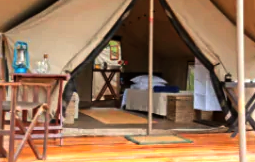
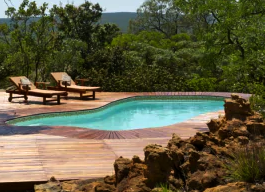 A horseback safari allows you to cover significant distances in remote areas, some beyond the reach of vehicles. Experienced riders can choose between a progressive horseback safari with nights in different camps or under the stars, or a stationary equestrian safari around a comfortable lodge. For those less experienced, but who would like to go on a horseback safari, our stationary safari with shorter and calmer horseback riding is offered: ideal if you are accompanied by a non-rider or with your family !
A horseback safari allows you to cover significant distances in remote areas, some beyond the reach of vehicles. Experienced riders can choose between a progressive horseback safari with nights in different camps or under the stars, or a stationary equestrian safari around a comfortable lodge. For those less experienced, but who would like to go on a horseback safari, our stationary safari with shorter and calmer horseback riding is offered: ideal if you are accompanied by a non-rider or with your family !
Our horseback safaris have been selected by partner agencies, specialists in equestrian safaris. These agencies carries out a particularly rigorous selection of equestrian service providers, from a large range of equestrian safaris.

